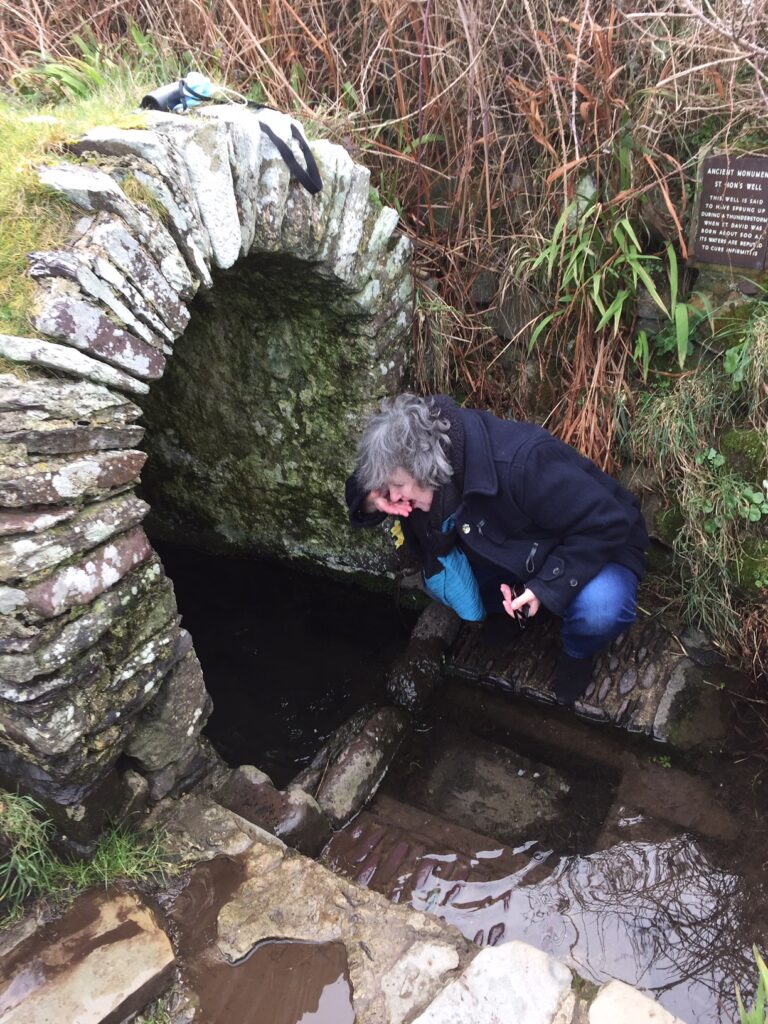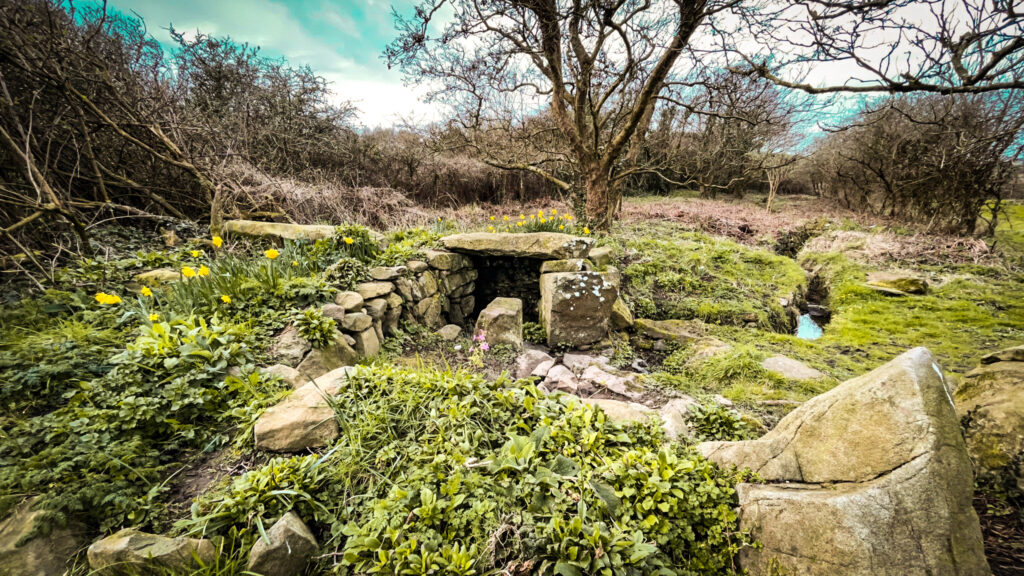Recently, I wrote my first blog in a long time about some of the holy wells I had come across in Pembrokeshire. It will be the first of a few, leading up to the publication of my chapbook featuring two of those wells, ’The Song of the Water’ (which I’ll be talking more about in the On Land’s Edge Festival, as mentioned in my previous post).
So I thought I would copy that blog here, for additional reference.
Holy Wells – Connections, Ancient and Recent
It’s so strange that my last blog was about a workshop I attended with Ancient Connections.
I said then that I was going to use my blog for discussions about my stories, where they come from, how they develop from idea to page.
Sadly, that hasn’t happened – mainly because I’ve been too busy writing the stories… which is actually the best of reasons!
And one of the main projects I’ve been working on this year, is a commission for… Ancient Connections.
I shouldn’t really be surprised at this synchronicity. It’s something I referred to in that last blog – how one story led to another, how research on one topic can open up previously unknown subjects – which lead to more stories.
And I seem to come across it more and more often, lately.
For example, while I was researching my novella, ‘The Sisters of Cynvael’, (to be published next year by Cinnamon Press), I found a site that said the best place to park for exploring the Cynfal River was a lay-by on the A470. So when Arachne Press was seeking submissions for its A470 poetry anthology, I remembered this, and thought the juxtaposition of the modern road and the mythological Cynfal valley would be a good basis for a poem. And so it turned out, when my poem, ‘Blodeuwedd Crosses the Road’, was chosen for publication in the book.
Similarly, the setting of my novella – a dense wood, leading up to mountains – suggested the setting of my story ‘The Quiet’, which featured in Honno’s Welsh Women Writing Crime anthology, ‘Cast a Long Shadow’.
It was when I was working on these last autumn that Ancient Connections requested submissions of artistic work of various forms, including literature.
As mentioned in that last blog, Ancient Connections is an arts, heritage and tourism project, linking North Pembrokeshire and North Wexford, further details of which can be found on their website https://ancientconnections.org This latest project was on the theme of holy wells in these areas, particularly, on the Pembrokeshire side, Fishguard, Goodwick and St David’s.
I decided to apply, with a brief suggesting short stories based on certain local wells (purely fictional representations), and was thrilled to have my proposal accepted, in a modified form, in order to combine it with the work of other artists, in a series. I am particularly delighted that my stories will be illustrated by the wonderfully talented Flora McLachlan, and will also be translated into Welsh. There will also be a Wexford equivalent, written by Michelle Dooley Mahon. It will be interesting to see our different approaches.
So, leading up to the publication of the chapbook, I thought I would write a series of blogs about various Holy Wells in Pembrokeshire, ending with a more detailed look at my chosen Chapbook stories.
I’ll also publish these articles on my website, so that there will be a record of them on that, as well.
I’m going to begin with a general overview, here, before writing about individual wells, leading up to my own particular stories, further along.
As I knew little about Pembrokeshire’s wells previously, it was necessary for me to begin with research. (Strangely enough, though, in another example of synchronicity, the short story I had most recently finished featured the one-time spring/well at St Edren’s church, a mile or two up the road from me – a place and piece of folklore I had come upon by chance, during lock-down. This story ‘A Cure for all our Ills’ has since been shortlisted for the Bristol Prize, and I love the fact that amid two thousand international entries this little corner of Pembrokeshire has stood out!)
There are several useful sites on the internet, some specifically about Welsh wells, and others about wells in general. But there are two indispensable books necessary for the Welsh ‘well-hunter’. These are: ‘The Holy Wells of Wales’ by Francis Jones (1954, p/b edition University of Wales Press, 1992) and ‘The Living Wells of Wales’, by Phil Cope (Seren, 2019). As their titles suggest, these cover the whole of the country, but there is plenty about Pembrokeshire in both, partly on account of the prevalence of wells here.
Pembrokeshire has more wells than any other county, with Jones citing two hundred and thirty-six in his study. Ancient beliefs were often pushed to the margins of a country – and the belief in the power of well-water and the rituals surrounding it is certainly ancient. And, of course, Pembrokeshire is the ‘home’ of St. David, and numerous other saints. It was, therefore (and is!) a place of pilgrimage, and pilgrims need the sustenance and spiritual benefits such wells supply during their journeys.

It is hardly surprising that I found myself spoilt for choice – so many wells, so many interesting facts, so many stories told about them.
I also began to visit some of them, including some that weren’t in the chosen area, to see them for myself, and to absorb the atmosphere surrounding them. In some cases, of course, this is vastly different from how it would have been centuries ago, as are the wells themselves. This is something it is important to remember. What we ‘see’ and what we ‘know’ may have very little to do to how things were, when the wells were visited for simple village needs, Christian purposes, and for ‘pagan’ practices.
Folklore and stories passed down through the generations may give us some insight into the latter. With regard to the religious, Rhygyfarch’s ‘Life of Saint David’ is the source of much information, but it was written in the eleventh century, five hundred years after David’s death.
It is therefore necessary to take it all with a pinch of salt, which is, actually, very freeing for the writer, as you can let your imagination run wild.
I decided on a few key points from the start – I would understand ‘holy’ in not purely Christian terms; I wanted to stress the value of water in all its forms;
and, most particularly, I wanted to write from a female point of view – to reclaim the wells for women. After all, women were the original guardians of the wells, and appear on the edges of many of the tales. Now I wanted to put them centre stage.
St Non is, of course, an obvious choice for this. Her well, in its beautiful location, on the cliff-tops between her son’s cathedral and the sea, is still visited by pilgrims today, as she is still celebrated as the mother of our patron saint.
Another well in a gorgeous setting is St Gwyndaf’s (St Wnda) in Llanwnda. I was lucky enough to visit it for the first time on a day of blue sky and sea, and Spring colour. The hamlet has become famous for its role in the Last Invasion and its lovely church. But the well offers another story – or many more stories.
And I had learnt by then that St Gwyndaf had a wife.

So I decided to write about St Non, and Gwenonwy, Gwyndaf’s wife. Non has been written about so many times, whereas little is known or written about Gwenonwy. Word count was limited, so I settled on a short piece on Non, and a longer account of what may, or may not, have happened to Gwenonwy at Llanwnda.
And, fortunately, the resulting work was approved by the Ancient Connections team, and it won’t be long before it goes to press, and is launched into the world.
But with so much fascinating material out there, I fully intend to write more stories in the future. And I shall also be visiting the wells again. Some of them are to be found in neglected spaces, so it is a pleasure to follow pathways normally untrodden, to see what lies at their end – a new way of exploring our wonderful county.
Some, indeed, are in the strangest of places – more of which in my next post.
